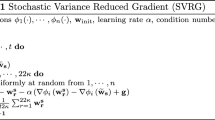Abstract
During the last decade, the data sizes have grown faster than the speed of processors. In this context, the capabilities of statistical machine learning methods is limited by the computing time rather than the sample size. A more precise analysis uncovers qualitatively different tradeoffs for the case of small-scale and large-scale learning problems. The large-scale case involves the computational complexity of the underlying optimization algorithm in non-trivial ways. Unlikely optimization algorithms such as stochastic gradient descent show amazing performance for large-scale problems. In particular, second order stochastic gradient and averaged stochastic gradient are asymptotically efficient after a single pass on the training set.
Access this chapter
Tax calculation will be finalised at checkout
Purchases are for personal use only
Preview
Unable to display preview. Download preview PDF.
Similar content being viewed by others
References
BORDES. A., BOTTOU, L., and GALLINARI, P. (2009): SGD-QN: Careful Quasi-Newton Stochastic Gradient Descent. Journal of Machine Learning Research, 10:1737-1754. With Erratum (to appear).
BOTTOU, L. and BOUSQUET, O. (2008): The Tradeoffs of Large Scale Learning, In Advances in Neural Information Processing Systems, vol.20, 161-168.
BOTTOU, L. and LECUN, Y. (2004): On-line Learning for Very Large Datasets. Applied Stochastic Models in Business and Industry, 21(2):137-151
BOUSQUET, O. (2002): Concentration Inequalities and Empirical Processes Theory Applied to the Analysis of Learning Algorithms. Thèse de doctorat, Ecole Polytechnique, Palaiseau, France.
CORTES, C. and VAPNIK, V. N. (1995): Support Vector Networks, Machine Learning, 20:273-297.
DENNIS, J. E., Jr., and SCHNABEL, R. B. (1983): Numerical Methods For Unconstrained Optimization and Nonlinear Equations. Prentice-Hall
JOACHIMS, T. (2006): Training Linear SVMs in Linear Time. In Proceedings of the 12th ACM SIGKDD, ACM Press.
LAFFERTY, J. D., MCCALLUM, A., and PEREIRA, F. (2001): Conditional Random Fields: Probabilistic Models for Segmenting and Labeling Sequence Data. In Proceedings of ICML 2001, 282-289, Morgan Kaufman.
LEE, W. S., BARTLETT, P. L., and WILLIAMSON, R. C. (1998): The Importance of Convexity in Learning with Squared Loss. IEEE Transactions on Information Theory, 44(5):1974-1980.
LEWIS, D. D., YANG, Y., ROSE, T. G., and LI, F. (2004): RCV1: A New Benchmark Collection for Text Categorization Research. Journal of Machine Learning Research, 5:361-397.
LIN, C. J., WENG, R. C., and KEERTHI, S. S. (2007): Trust region Newton methods for large-scale logistic regression. In Proceedings of ICML 2007, 561-568, ACM Press.
MACQUEEN, J. (1967): Some Methods for Classification and Analysis of Multivariate Observations. In Fifth Berkeley Symposium on Mathematics, Statistics, and Probabilities, vol.1, 281-297, University of California Press.
MASSART, P. (2000): Some applications of concentration inequalities to Statistics, Annales de la Faculté des Sciences de Toulouse, series 6,9,(2):245-303.
MURATA, N. (1998): A Statistical Study of On-line Learning. In Online Learning and Neural Networks, Cambridge University Press.
POLYAK, B. T. and JUDITSKY, A. B. (1992): Acceleration of stochastic approximation by averaging. SIAM J. Control and Optimization, 30(4):838-855.
ROSENBLATT, F. (1957): The Perceptron: A perceiving and recognizing automaton. Technical Report 85-460-1, Project PARA, Cornell Aeronautical Lab.
RUMELHART, D. E., HINTON, G. E., and WILLIAMS, R. J. (1986): Learning internal representations by error propagation. In Parallel distributed processing: Explorations in the microstructure of cognition, vol.I, 318-362, Bradford Books.
SHALEV-SHWARTZ, S. and SREBRO, N. (2008): SVM optimization: inverse dependence on training set size. In Proceedings of the ICML 2008, 928-935, ACM.
TIBSHIRANI, R. (1996): Regression shrinkage and selection via the Lasso. Journal of the Royal Statistical Society, Series B, 58(1):267-288.
TJONG KIM SANG E. F., and BUCHHOLZ, S. (2000): Introduction to the CoNLL-2000 Shared Task: Chunking. In Proceedings of CoNLL-2000, 127-132.
TSYBAKOV, A. B. (2004): Optimal aggregation of classifiers in statistical learning, Annals of Statististics, 32(1).
VAPNIK, V. N. and CHERVONENKIS, A. YA. (1971): On the Uniform Convergence of Relative Frequencies of Events to Their Probabilities. Theory of Probability and its Applications, 16(2):264-280.
WIDROW, B. and HOFF, M. E. (1960): Adaptive switching circuits. IRE WESCON Conv. Record, Part 4., 96-104.
XU, W. (2010): Towards Optimal One Pass Large Scale Learning with Averaged Stochastic Gradient Descent. Journal of Machine Learning Research (to appear).
Author information
Authors and Affiliations
Corresponding author
Editor information
Editors and Affiliations
Rights and permissions
Copyright information
© 2010 Springer-Verlag Berlin Heidelberg
About this paper
Cite this paper
Bottou, L. (2010). Large-Scale Machine Learning with Stochastic Gradient Descent. In: Lechevallier, Y., Saporta, G. (eds) Proceedings of COMPSTAT'2010. Physica-Verlag HD. https://doi.org/10.1007/978-3-7908-2604-3_16
Download citation
DOI: https://doi.org/10.1007/978-3-7908-2604-3_16
Published:
Publisher Name: Physica-Verlag HD
Print ISBN: 978-3-7908-2603-6
Online ISBN: 978-3-7908-2604-3
eBook Packages: Mathematics and StatisticsMathematics and Statistics (R0)





